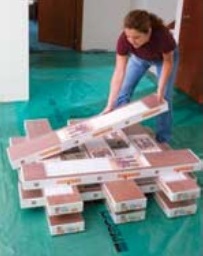Acclimating Your New Floors

Have we mentioned that you should acclimate your new flooring? Once, twice, maybe? A little refresher course never hurts, so we’re going to go over how to do it and why it matters.
Think of acclimation like an adjustment period. Acclimating your floors prior to installation is important because flooring material (particularly hardwood) is affected by the temperature and humidity in your home. These materials will expand or contract (their way of adjusting to your home) based on its environmental conditions, and much of that will have settled into a new normal for your material by the end of the acclimation period.
So, how do you acclimate a new floor? You stack your cartons so the air can get to them. You can do this 'log cabin style', as pictured below, or if you have few enough cartons, you can prop them up against your walls.

1. To prevent moisture-related issues such as board edge cupping, all wet work involving water or moisture (plumbing, plaster/drywall ceilings or wall finishes, painting, etc.) should be finished with ample time allowed for complete drying prior to wood floor installation. New concrete should be cured and at least 60 to 90 days old.
2. Heating and air conditioning systems should be fully operational and running as normal at least seven days before the installation, so that the floor will be allowed to attain its ideal moisture content under the home’s normal temperature and humidity conditions. In more technical terms, this process is designed to allow new hardwood flooring to reach its Equilibrium Moisture Content (EMC).
The ideal temperature range is between 60 and 80 degrees Fahrenheit, and the ideal humidity is your regional average, i.e., the average humidity in Florida will be different than the average in Nevada, so be sure to take that into account when getting ready to acclimate a new floor.
Moisture content can be measured with a moisture meter, available at most hardware stores.
3. Acclimation periods for hardwood can range anywhere from one to seven days. Your product's documentation (which we post on every product's own page) will give you your specifics. Acclimation periods are often the same for both solid and engineered hardwood, although acclimation time can differ between domestic hardwood species and exotic hardwood species.
Just like with hardwood, laminate needs time. First, decide when you want to install your new floor, and have your laminate brought to your home at least two days prior to that.
Store laminate flooring flat in the room where it’s going to installed, for a minimum of 48 hours, in unopened packaging at room temperature between 60 and 85 degrees Fahrenheit with a maximum of 75% relative humidity. For floors with radiant heating, make sure to turn down your thermostat to 60 degrees Fahrenheit at least one week prior to installation (do not turn off heating if the temperature outside is below freezing). Maintain the temperature below 80 degrees Fahrenheit.
BAMBOO
Did you know bamboo is a grass and not a wood? Now you do! Since bamboo is not a wood, it’s going to have different behaviors and needs than a wood. For example, bamboo expands and contract along its length and its ends than it does widthwise.
It’s important to know which of the two types of bamboo flooring you’ve got, because a strand woven bamboo floor will have different needs than a vertical or horizontal bamboo floor. According to the National Wood Flooring Association, a strand woven bamboo floor will take longer to acclimate than its vertical or horizontal counterparts.Horizontal solid bamboo will expand and contract more than vertical bamboo, and strand-woven bamboo will expand and contract just like solid wood flooring.
Bamboo requires a minimum acclimation period of 72 hours.
CORK
While most people’s minds don’t immediately jump to cork when they think of flooring, that same natural wood material used for bulletin boards and keeping a bottle of vino fresh also makes a great, eco-friendly flooring product!
Cork floors require an acclimation period of at least 48 hours in a dry, well-ventilated area, ideally in the room it’s going to be installed. Just like with hardwood, acclimate cork with the average moisture and humidity for your area. Store cork flooring flat, in open packaging, at room temperature between 60 and 85 degrees Fahrenheit with a maximum of 75% relative humidity.
WHAT NEXT?
The expansion and contraction of wood material doesn’t end with acclimation. It’s a natural process that needs to be taken into account throughout the life of your floors, and keeping that in mind will improve both your floor’s performance and your satisfaction with it. Very dry or humid regions usually require extended conditioning. Maintaining recommended acclimation levels even after the installation will minimize board movement, excessive squeaks and gaps.
Here are some great tips for a successful acclimation from Flooring-Professionals.com:
- –Always store flooring material in a dry place
- –Don’t deliver flooring materials in inclement weather, i.e., don’t have your floors delivered in a monsoon
- –Don’t store flooring materials directly on concrete. Elevate the materials at least 4 inches above the concrete
If you’ve got any questions about acclimation time, moisture conditions, or anything else about your great new floors, don’t hesitate to call or chat with our dedicated flooring experts today!
Follow Team Floors To Your Home on Facebook

 Brown Tone
Brown Tone
 Unfinished
Unfinished
 Red Tone
Red Tone
 Golden Tone
Golden Tone
 Gray Tone
Gray Tone
 Light Tone
Light Tone
 Medium Tone
Medium Tone
 Dark Tone
Dark Tone
 Brown Tone
Brown Tone
 Red Tone
Red Tone
 Golden Tone
Golden Tone
 Gray Tone
Gray Tone
 Light Tone
Light Tone
 Medium Tone
Medium Tone
 Dark Tone
Dark Tone
 Brown Tone
Brown Tone
 Red Tone
Red Tone
 Golden Tone
Golden Tone
 Gray Tone
Gray Tone
 Light Tone
Light Tone
 Medium Tone
Medium Tone
 Dark Tone
Dark Tone
 Multi Color
Multi Color
